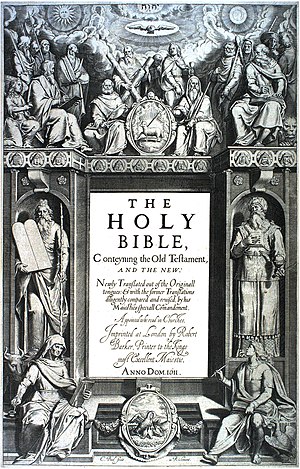
Pre-1611 music service
On November 20, 2011 the Church of the Mediator Episcopal church in Micanopy, FL ( held a service that focused on the 400th Anniversary of the King James Version of the Bible. To try and keep the service as much musically like what people may have heard in 1611, we tried to select appropriate music.
The scripture was, of course, from the King James version. We used the original edition, complete with the different spellings used in 1611.
Hymns
In researching hymn tunes and lyrics that were written prior to 1611, we discovered that few English language hymns exist. It was about 100 years later that English language hymnody really took off with such authors as Isaac Watts. Although there are numerous foreign language pieces (eg. German) that were possibilities, but the translations, such as A Mighty Fortress, were written long after 1611 so we did not use those titles.
We could only find about 7 hymns that would work. Of those, the following were chosen. Even with these, some of the translations or harmonizations were done after 1611.
- Jerusalem, My Happy Home (Tune: Diana)
- Psalm 23 metrical version (Tune: St. Flavian)
- The Lord Descended from above (Tune: Moravian)
- All People That On Earth Do Dwell (Tune: Old 100th)
- I Call On Thee, Lord Jesus (Tune: Ich Ruf Zu Dir)
The hymn I Call on Thee was written by Miles Coverdale (1487-1568) who is probably best known for his Coverdale Psalms, a translation of Psalms. The hymn tune dates to 1533 but was harmonized in 1928. It is found in the 1982 Episcopal Hymnal as hymn 634.
All People That On Earth Do Dwell is set to the tune Old 100th, best known to many as the Doxology. The words by William Keth (d. ~1608) and is a paraphrase of Psalm 100. In this case, the lyrics and music are all written pre-1611. The music is from 1551 and harmonized prior to 1561. This is probably the oldest hymn with lyrics and music commonly used by congregations today.
Jerusalem, My Happy Home was written in the 16th century. The melody, tune: Diana, is a traditional English melody from the 16th century. The setting we used was harmonized in 1939.
The metrical Psalm setting of Psalm 23 we used was to the tune St. Flavian, sung often to the lyrics Lord, Who Throughout These Forty Days. This tune dates from 1562.
The Lord Descended From Above is another Sternhold Psalm. The tune is Moravian from pre-1611. The edition we used was from an 1882 Church of Christ/Presbyterian hymnal.
Organ Music

I do not have access to any original edition organ publications pre-1611. I did have several arrangements or adaptations of pre-1611 organ music.
For pre-service music, I played the following:
- Pavane, by William Byrd
- Salmodia para el Magnificant by Antonio de Cabezon, arranged by E. Power Biggs
- Dialogo per Organo by Adriano Banchieri, arranged by E. Power Biggs
- St. Flavian (tune)
During communion I played the following titles. In the E. Power Biggs edition I had, they were grouped together as one piece, in two sections:
- 1. Pavana – The Earle of Salisbury from Parthenia or The Maydenhead (1611) by William Byrd
- 2. Galiardo also from Parthenia or The Maydenhead (1611) by William Byrd

5 replies on “Using pre-1611 music”
James Gilbert did a great job of coming up with some period music. The great congregational writers like Isaac Watts, John and Charles Wesley, and John Newton were all well after 1611.
I have been browsing online greater than three hours as of late, yet I never found any attention-grabbing article like yours. It is pretty worth enough for me. Personally, if all web owners and bloggers made good content as you probably did, the internet will be a lot more helpful than ever before. “I thank God for my handicaps, for through them, I have found myself, my work and my God.” by Hellen Keller.
Is it possible to find out the words which were connected with this tune in XVI c.? Whas it a story of mythological Diana and Acteon or some other Diana?
According to the music I have, the tune is a traditional English melody. That makes me suspicious that it had anything to do with any mythological story. The naming of hymn tunes is often based on the names of Saints. There is a Saint Diana, a nun in the 13th century. I suspect the tune name is related to her. I can’t find any more information on the tune and would welcome any reliable sources that do give more information.
Thank You for the reply! I’ve found (glory to google-books) the book of Jeanice Brooks – Courtly Song in Late Sixteenth-Century France- p350 – she mentions the romancee of Belleforest – La Diana que je sers — as being very popular… I’ve writted to her but she is now out of the university until March.